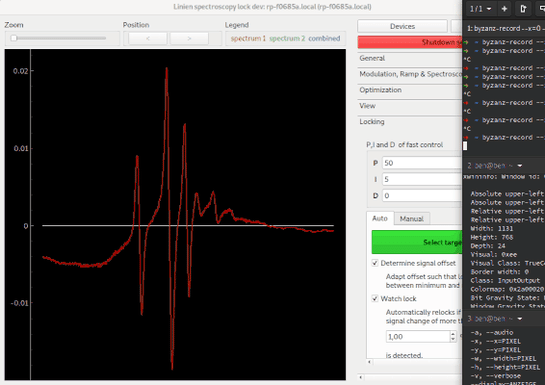Linien ‒ User-friendly Locking of Lasers Using Red Pitaya (STEMlab 125-14) That Works Every Time
-
Posted by
 Red Pitaya Team
, January 3, 2024
Red Pitaya Team
, January 3, 2024
-1.png)
In the intricate world of spectroscopy and laser locking techniques, precision and user-friendliness are paramount. Linien, a cutting-edge application developed for Red Pitaya's STEMlab 125-14, stands out as a beacon of innovation in this field. Created by scientists and professors at Humboldt University of Berlin, Linien is an open-source project that has garnered support from the German Space Agency (DLR) through funds provided by the Federal Ministry of Economics and Technology (BMWi) under grant number DLR50WM2066.
Key Features of Linien:
- Versatile Locking Techniques: Linien is designed primarily for locking spectroscopy signals but is adaptable to Pound-Drever-Hall and other lock-in techniques, as well as simple PID operation. Its flexibility makes it a valuable tool in various scientific applications.
- FPGA-Powered Functionality: Linien utilizes the power of FPGA for implementing Sinusoidal modulation (up to 50 MHz), demodulation (1f to 5f), filtering, and servo functions. This ensures high-performance signal processing directly on the Red Pitaya platform.
- Client-Server Architecture: Linien adopts a client-server architecture, allowing autonomous operation on the Red Pitaya platform. Multiple GUI or Python clients can connect to the server, providing users with a seamless and collaborative experience.
- Autolock Algorithm: Linien introduces an Autolock feature that simplifies the locking process. Users can click and drag over a line, and Linien will automatically lock to the selected signal. This algorithm is engineered to be noise- and jitter-tolerant, enhancing the reliability of the locking process.
- IQ Demodulation and Noise Analysis: The application offers IQ demodulation for optimizing the demodulation phase. Additionally, users can perform noise analysis by recording the power spectral density (PSD) of the error signal. This aids in analyzing the noise characteristics of the locked laser and optimizing the PID parameters.
- Lock Detection and Automatic Relocking: Linien is equipped with lock detection capabilities. In the event of a lock loss, the application autonomously triggers relocking, ensuring continuous and stable operation.
- Machine Learning Integration: Linien leverages machine learning to fine-tune spectroscopy parameters, optimizing the signal for enhanced performance.
- Remote Controllability: Users can remotely control or monitor the spectroscopy lock using Python through client libraries, adding a layer of convenience to the experimental setup.
- Dual-Channel Spectroscopy Support: Linien supports dual-channel spectroscopy, enabling the implementation of combined FMS+MTS (Frequency Modulation Spectroscopy + Modulation Transfer Spectroscopy).
- Logging Capabilities: Lock status and parameters can be logged to InfluxDB v2, facilitating data tracking and analysis.
- Integration with Piezo Control: Linien includes a second integrator for the slow control of a piezo in an Extended Cavity Diode Laser (ECDL).
- GPIO Outputs and Analog Outputs: The application gives users control over Red Pitaya’s 16 programmable GPIOs, which act as outputs for controlling other devices. Additionally, users can leverage the GUI or Python client to utilize additional analog outputs (ANALOG_OUT 1, 2, and 3).
In conclusion, Linien represents a significant leap forward in the realm of laser locking applications. Its robust features and user-friendly interface make it a valuable asset for scientists and researchers seeking precision and efficiency in their experiments. The open-source nature of Linien reflects a commitment to collaborative scientific advancement, with ongoing support from the German Space Agency highlighting its importance in cutting-edge research endeavors.
More information regarding Linen and its source code is available here: https://github.com/linien-org/linien
Want to know more? Read also Linien – A versatile, user-friendly and open-source tool for laser stabilization based on the Red Pitaya STEMlab platform
About the Red Pitaya Team
The Red Pitaya editorial team consists of engineers, researchers, and product experts who develop and test cutting-edge open-source test & measurement solutions.
Our mission is to make advanced instrumentation accessible to everyone — from students and educators to leading research labs worldwide.




